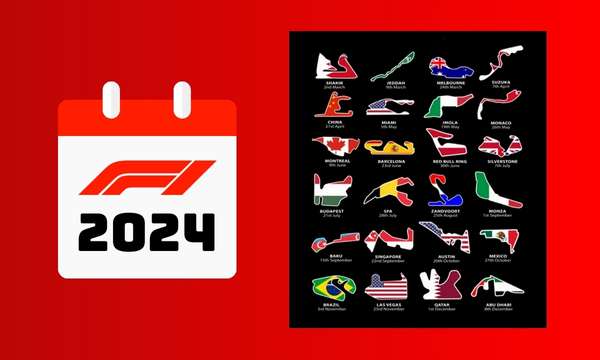Embark on an exciting journey through the universe of speed, exploring the fascinating Formula 1 calendar and the iconic tracks!
Ad
Are you ready for an electrifying tour of the world of Formula 1? In this post, we will explore the Formula 1 calendar and the tracks that challenge the most skilled drivers on the planet, delving into its dizzying curves, challenging straights and iconic locations that are part of motorsport.
As well as exploring the unique features of each circuit, we’ll delve deeper into the fascinating facts, discovering how changes over the years have shaped the Formula 1 calendar and influenced the fate of the races.
And to not miss any overtakes or thrilling turns, check out the best apps to watch F1 races live on your mobile.
What are Formula 1 tracks?
Formula 1 tracks are more than just asphalted routes. They are true works of engineering, designed to test the limits of cars and drivers, demanding precision and courage. They vary in length, complexity and features, providing unique challenges for drivers and teams.
Each circuit has unique characteristics, from tight curves that require sudden braking to long straights that invite dizzying speed.
How are tracks chosen for F1?
Choosing the tracks to host the Grands Prix (GPs) of Formula 1 is a rigorous process. The International Automobile Federation (FIA) works together with race organizers and teams to select circuits, taking into account several factors, such as:
- Safety:The track must meet the highest safety standards, with adequate escape areas and measures to minimize the risk of accidents.
- Infrastructure: The circuit needs to be able to accommodate a large audience, teams and media infrastructure.
- Challenge: The track must be challenging for drivers and cars, providing exciting and unpredictable races.
- Location: Formula 1 is looking to expand its global reach, so the location of the track is also important to attract new fans.
The challenges of each Formula 1 circuit
Each Formula 1 circuit presents its own challenges, requiring adaptations from drivers and teams. From the high-speed curves of Monza to the tight streets of Monaco, drivers face a variety of obstacles that test their skill, courage and concentration.
The elevation change, unpredictable weather conditions and the technical nature of certain tracks add an extra layer of complexity to the races. For example, the Spa-Francorchamps track in Belgium is famous for its unpredictable rain. Really, an added challenge!
The most famous circuits of the current season
Some Formula 1 circuits have already become legends, the stage for historic moments and epic races. Among the most famous, we can highlight:
- Monaco: A narrow and winding urban circuit, which requires a lot of skill from drivers to avoid walls.
- Monza: A historic track with long straights that allow impressive speeds.
- Silverstone: A classic English circuit, with a mix of fast and technical corners.
- Suzuka: A challenging track in Japan known for its figure-8 curves.
- Interlagos: A fascinating circuit in Brazil, a stage for great emotions and twists and turns.
- Spa-Francorchamps: Known for its challenging mix of fast turns and elevation changes.
Curiosities about Formula 1 tracks
- The longest track on the current Formula 1 calendar is the Circuit of the Americas in the United States, at 5,513 km.
- The Monaco Circuit has the shortest track, at 2,605 km.
- The Monaco GP is the slowest on the Formula 1 calendar, with significantly lower average speeds than other races.
- The track with the highest average speed is Monza, in Italy, where cars can reach more than 360 km/h.
- The Spa-Francorchamps circuit has the most famous corner in Formula 1, Eau Rouge.
- At racetrack Hermanos Rodríguez, in Mexico, there is the track with the highest altitude, at 2,285 meters above sea level.
Changes in the calendar over the years
Over the years, the Formula 1 calendar has undergone several changes with the inclusion and exclusion of new tracks. Political, economic and security changes can influence decisions about race locations, leading to a regular rotation of circuits on the calendar.
How the Formula 1 calendar works
The Formula 1 calendar, also known as the FIA Formula 1 World Championship, is made up of a series of races, called the Grands Prix, held in different countries throughout the year. The season usually starts in March and ends in November, with each GP lasting three days.
Structure of a GP weekend:
Friday
- Free Practice 1: A 60-minute practice session for drivers to familiarize themselves with the track and test their cars.
- Free Practice 2: Another 60-minute training session for the riders to refine your settings and do race simulations.
Saturday
- Free Practice 3: A 60-minute practice session for drivers to make final adjustments to their cars and tires.
- Qualifying: A timed session to determine the starting order for the race. Qualification is divided into three parts: Q1, Q2 and Q3. The five slowest riders are eliminated after each part, until the ten fastest riders are eliminated.dispute pole position (first position on the grid).
Sunday
- Race: The main attraction of the weekend, lasting approximately two hours (or 305 km). The driver who crosses the finish line first wins the race.

What to expect from the circuits next season
The 2025 Formula 1 season promises even more excitement, with the addition of new circuits and the reformulation of some classics. Among the new features, we can mention:
- Return of the French GP: The legendary Paul Ricard track returns to the calendar after 10 years of absence.
- New track in China: A new circuit is being built in Shanghai, promising to be one of the most technological in the world.
- Reforms in Interlagos: The Brazilian track will undergo renovations to increase safety and improve the fan experience.
You can now look forward to another year of adrenaline, speed and excitement on the Formula 1 tracks! Follow the races, cheer for your favorite drivers and cheer with each spectacular overtake and maneuver. The world of Formula 1 is a show of engineering, skill and passion for motorsport, which invites you to speed along!



